Spring, Easter, renewal and all that…then the 10 degree temperature drop and the return to thermals.
‘Grief melts away/like snow in May’ writes the seventeenth century poet and priest George Herbert, experiencing the same highs and lows we experience in our so-different world, in his poem ‘The Flower’.
That poem has been a support and a holdfast to me for many years, both before I became a gardener (when ‘perennial plants’ was a purely theoretical knowledge), and once I had become one, when I felt the meaning of the poem better, because I knew from experience more of the life of ‘perennial plants’ by which it is inspired. These are the opening verses:
How fresh, oh Lord, how sweet and clean
Are thy returns! even as the flowers in spring;
To which, besides their own demean,
The late-past frosts tributes of pleasure bring.
Grief melts away
Like snow in May,
As if there were no such cold thing.
Who would have thought my shriveled heart
Could have recovered greenness? It was gone
Quite underground; as flowers depart
To see their mother-root, when they have blown,
Where they together
All the hard weather,
Dead to the world, keep house unknown.
Who would have thought? Certainly not me.
When I walked in the garden in February, under what seemed a sky of concrete, mostly blank and unmoving (though don’t forget, don’t forget, there were the Daphnes then scenting the air, don’t forget there was Camellia ‘Bob’s Tinsie’ burning his red fire) who would have thought that under the surface of the earth, life was being lived in its slow-beating winter way, ‘as flowers depart/To see their mother-root’?
No one would think ! Unimaginable! But I know that now, by practical experience.
Our spirits are also things of earth. There is no separation. That is to say, we are organic, carbon-based creatures who are also spiritual beings, and like everything of earth, our spirits also rise and fall, struggle up to the light and fade back down. I love ‘The Flower’ because it reminds me that it is possible for sorrow to fade, even as it gives me words for my sense of how hard being alive can be.
Living can be grievous. Yet, ‘Grief melts away/Like snow in May'.
And ‘my shrivelled heart’ can and does ‘recover greenness’, especially now as I look about me in Spring. That’s the miracle that is everywhere just now in the garden.
Many gardeners love Spring best, and I’m coming round to that sense myself. It used to be high summer drama for me, June, July , and even dusty August with her greens fading between still burning reds and oranges. But this year, perhaps not for the first time, but very strongly, I feel what those Spring-loving people are talking about. The powerful, almost choral, demonstration, by a huge range of plants, sings day after day that life returns. I walk around the garden and find that new life everywhere. Here it is, in the unfurling of a leaf.
Hostas have been a no for me because my sandy garden has always been snailful.
As rhymes with baleful. Since lockdown I have been making a concerted effort to reduce the snail population by seeking them out, putting them in a bag or bucket (pailful) and taking them to the park to live a more municipal life. That has worked to a certain extent - there are still snails here but nowhere near the numbers there used to be. And here is a Hosta, ‘Empress Wu’, which once would have been an unimaginable garden presence, although I do have to keep her elevated, up on a table so I can easily see if anyone is going for her. Full security detail for the Empress. On a table, with eggshell grit and a copper band.
Hostas, I read, are edible to humans as well as snails. But ‘Empress Wu’ will never be cooked, succulent though she currently looks. To look at the leaves unfolding fills me with a raging and inarticulate joy. Why? That she should be, and be so attuned, herself, to earth and sun. Yes, yes, I know that snails are waiting to eat her. That death will come. But by spending a few moments with her I also feel that life is living here, in a moment out of mortal time as I watch, daily, the leaves unfold. Life is here and undamaged, unspoiled. Unfallen as those of us who read Milton’s Paradise Lost might say. It’s a moment both in and out of our normal experience (because Spring’s a given, and yet when I stop to watch it, it is a revelation). A revelation, a miracle, that things should be perfect, young, beautiful for a few days.
This morning as the blackbird began his 5.00 am song outside my bedroom window and I lay thinking about what I was writing this week, a phrase from a poem by William Barnes came into my mind; ‘the young that died in beauty.’
William Barnes wrote in Dorset dialect and when I first met them I found his poems hard because of the need for translation. But now I’d say just read them aloud and it’ll mostly come to your mind. Here are the opening two verses from ‘The Young That Died in Beauty.’
If souls should only sheen so bright In heaven as in e’thly light, An’ nothen better wer the ceaese, How comely still, in sheaepe an’ feaece, Would many reach thik happy pleaece,— The hopeful souls that in their prime Ha’ seem’d a-took avore their time— The young that died in beauty. But when woone’s lim’s ha’ lost their strangth A-tweilen drough a lifetime’s langth, An’ over cheaeks a-growen wold The slowly-weaesten years ha’ rolled, The deep’nen wrinkle’s hollow vwold; When life is ripe, then death do call Vor less ov thought, than when do vall On young vo’ks in their beauty.
I think it was those last three lines that came to mind this morning, rising up unbidden from the deep well of ‘things I have read’ - it must be more than twenty five years since I last read William Barnes - though it was only the refrain, ‘the young that died in beauty’ that I could recall.
We don’t think so much about it when people die who are old, ‘when life is ripe’, because it is natural and inevitable and often a release but the loss of ‘young vo’ks in their beauty’ is a compellingly uneasy thought. As I look at the the beauty in the Spring garden I’m aware that this will pass and change, will grow old, will normalise, will ripen, will fall. And there we have it, that word again.
I don’t remember being so moved by Spring when young, perhaps because I was young myself and living mostly in that hope-filled glow. But now, as I’m approaching three score years and ten, the beauty of young vo’ks, whether plant or animal, appears as part of the beautiful fleeting annual resurgence of life, and while I breathe happily the beauty, it is the fleeting I feel.
More Spring Good in the Garden
I bought this lovely little Anemone Pavonina when I went to visit the Beth Chatto garden a few years ago. It was early April, and snowing when we arrived. And when the snow stopped the air was bitter and yet here they were, wonderful self-sown clumps of hot red or pink or white Pavonina all over the gravel garden.
I thought, that will do well in West Kirby, and bought a pot. Planted it. That was 2022. Next year, nothing, and nothing last year, so I had forgotten about the plant, and when the flash of pink caught my eye I thought it must be a tulip. But no, Anemone Pavonia, finally having settled in, roots down, young beautiful head up.
I’m no longer sure which perennial orange wallflower this is - possibly Erysimum ‘Apricot Twist’, which I certainly have bought from Shire Plants once or twice. You know when the obsession takes hold (or perhaps you can’t imagine an obsessive thought-loop that goes ‘I must get more of that perennial orange wallflower…I must… get more …wallflower…orange… must…orange…’?) The feeling is: a small carpet of that colour is what I must have. A small persian carpet of orange and green. The flowerheads are so small, so delicate asnd separate and of such a wonderful warmly clear burnt-amber… and with scent! I must have at least a metre of it.
I have tried to increase my stocks by cuttings and that has worked to a small extent. My little carpet covers about a quarter of a metre. Nowhere near enough. Must take some more cuttings. Need more. Must have.
Also a gorgeous orange colour, and with avery good narrow lily shaped flower, Tulipa Ballerina is slightly perennial. Some of them - about half I think - come back for a second year for me. But what happened this year I do not know: I planted at least fifty in the dead of winter, but as you can see, fifty have not come up.
Breaking News: Since writing that paragraph and taking that photograph I’ve been out for another look and found more are coming. I’d extended the run, down towards the house, where they will be more in shade. They are growing more slowly, but there are plenty more coming.
And we planted T. Ballerina at Calderstones, too. You can see a few of them alongside Volunteer Gardener Bev in the Front Border. The tulips seem too dispersed and too far back, but we struggle to plant here as the ground is impenetrably full of builder’s rubble. The holes go where we can make ‘em.
But what is really stunning there is another perennial wallflower, Erysimum ‘Fragrant Sunshine’. I am not a fan of yellow but the experience of this plant at Calderstones has encouraged me to change my mind.
Finally, what’s best in the garden this week is a little walk among the crab apple blossom. It will melt away all too soon, like snow in May or the young that died in beauty. My advice, wherever you are, is to go out and find a crabapple tree right now.

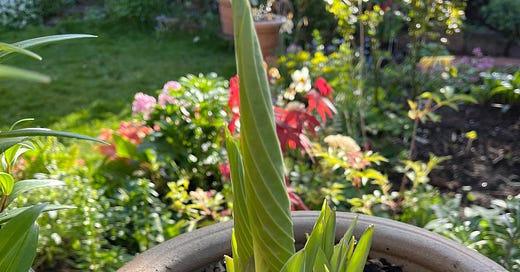




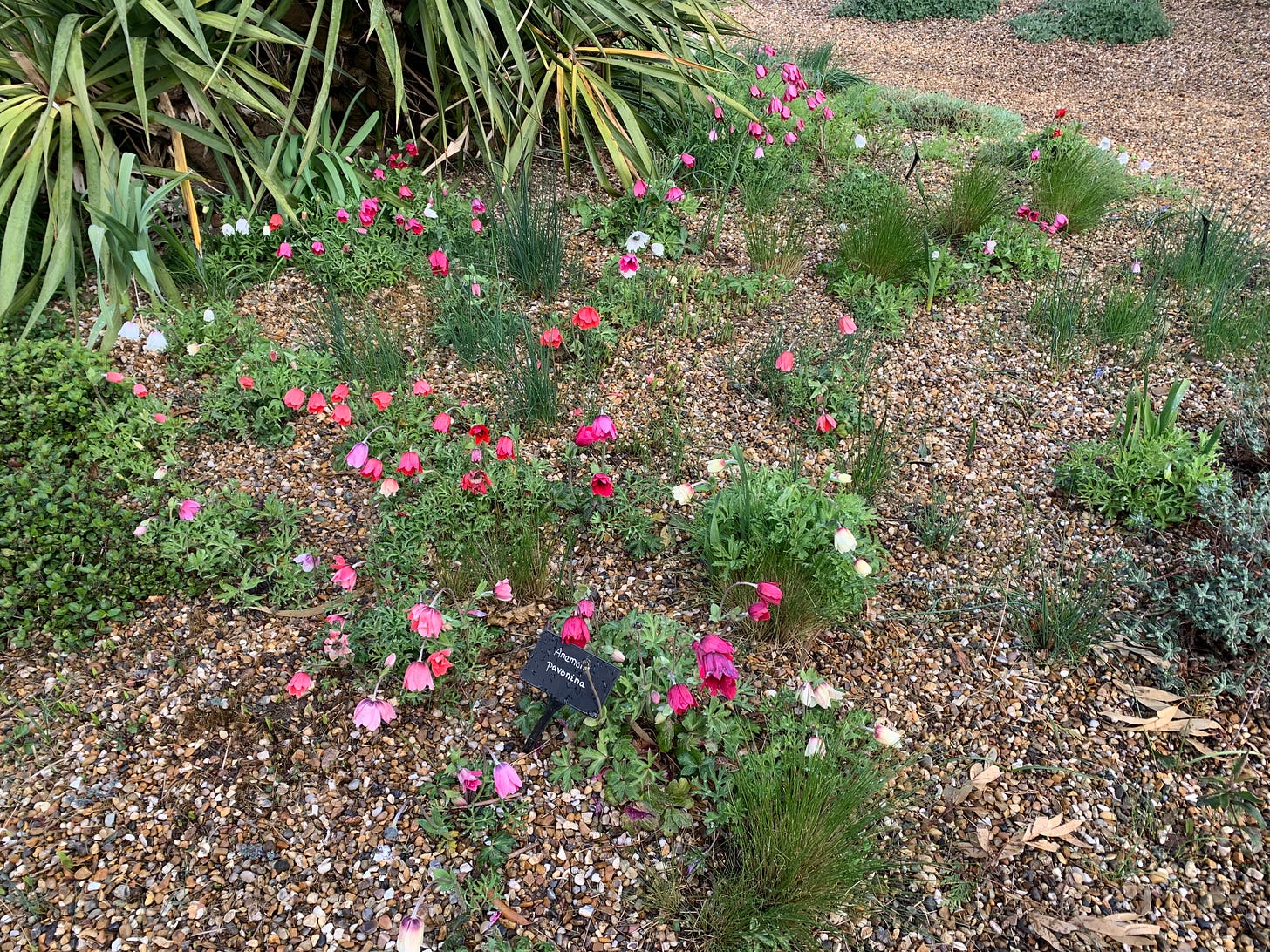
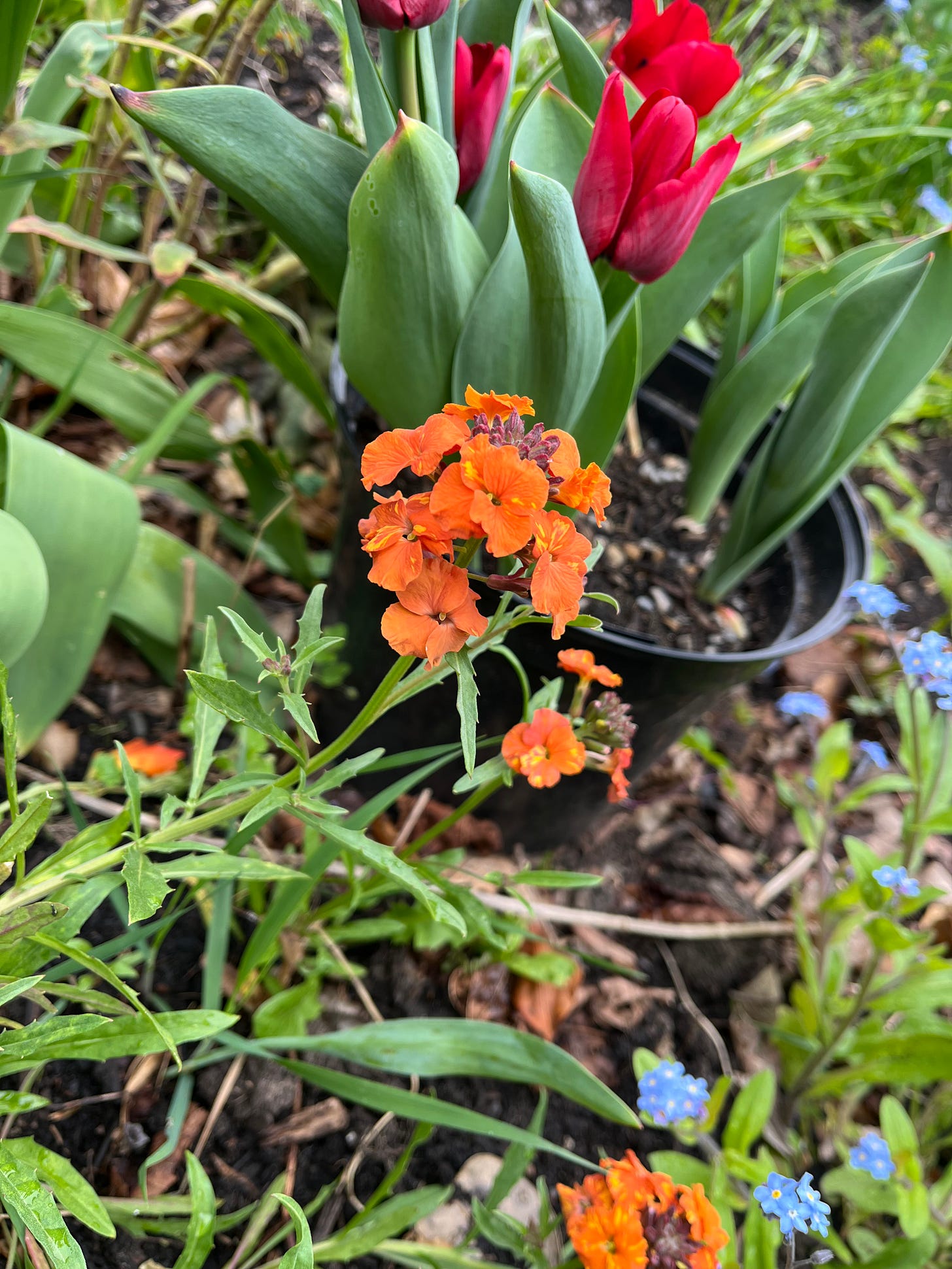

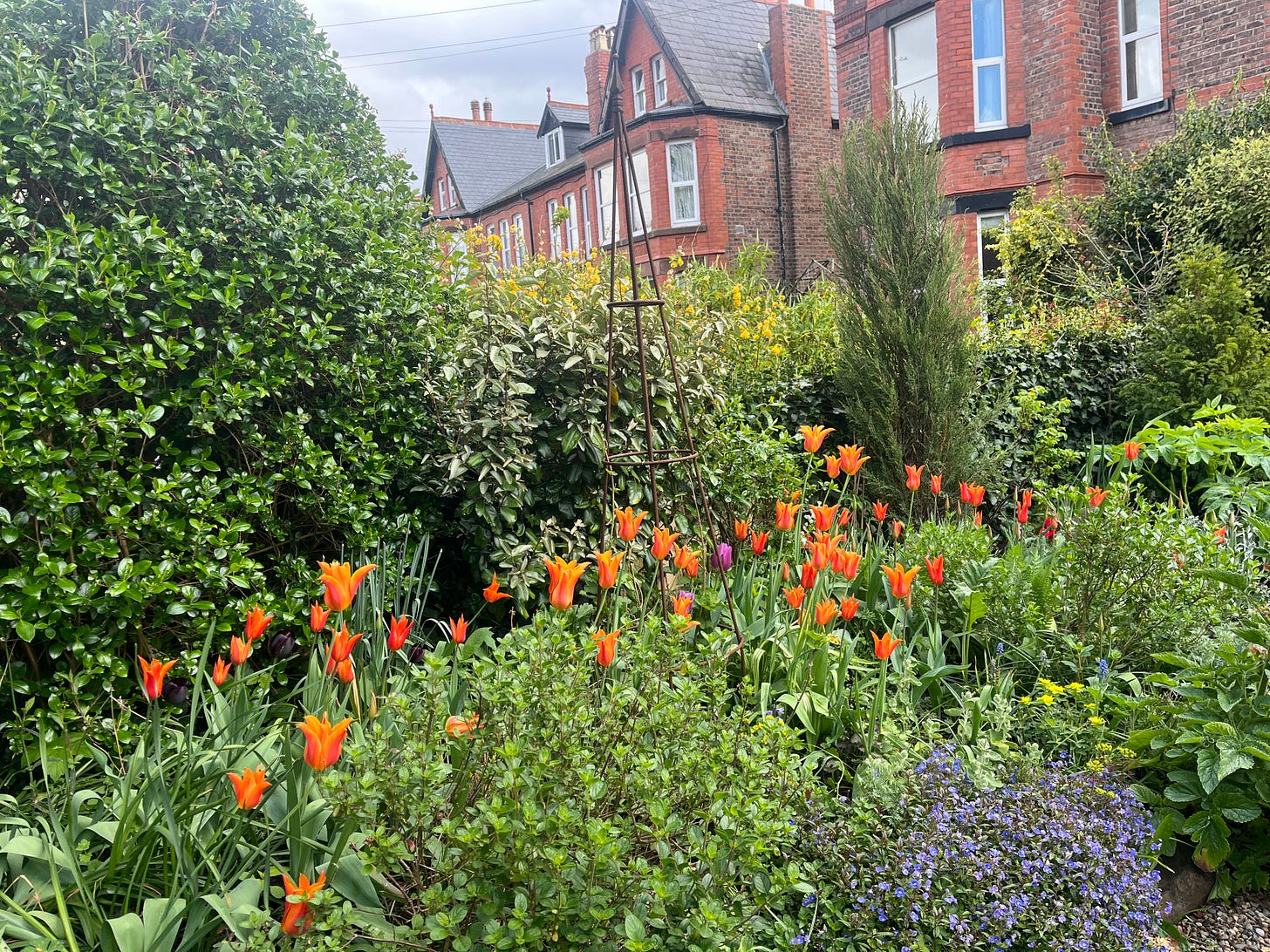


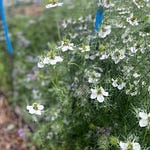
Share this post